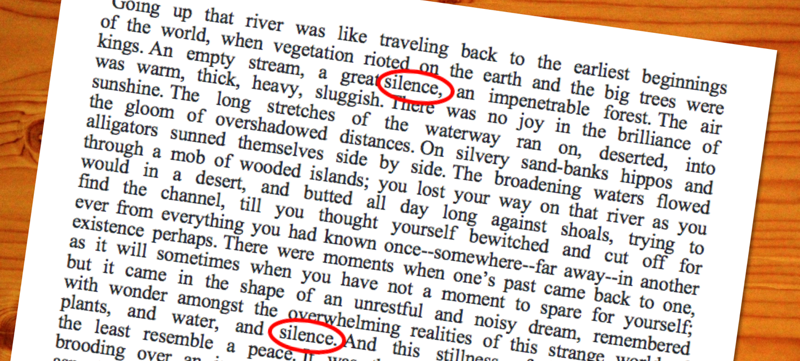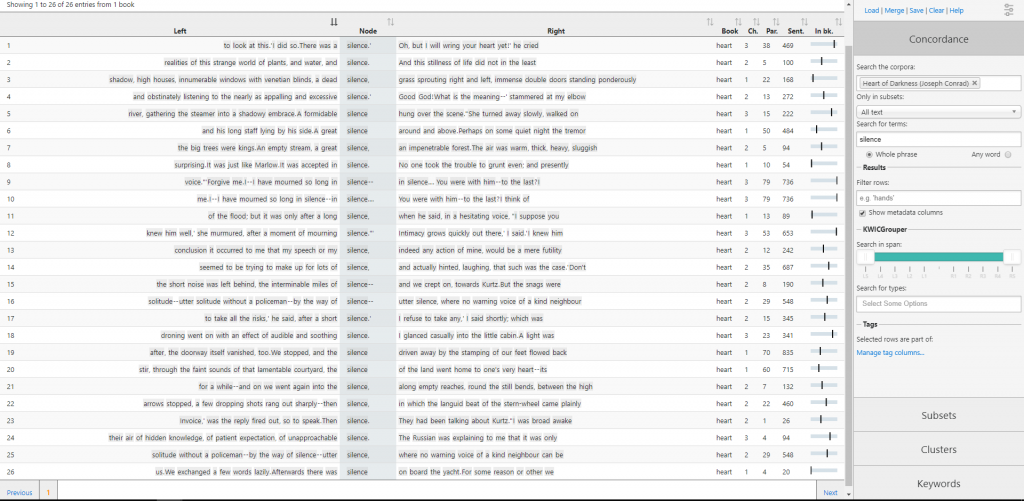As suggested by the famous song by Simon and Garfunkel, darkness and silence often go together in our imagination. Conrad’s novel Heart of Darkness seems to be no exception.

The to-and-fro movement from linguistic description to literary appreciation and interpretation is what traditional stylistics and modern computer stylistics have in common, along with the assumption that even the smallest detail can provide insight into the ‘soul’ of a work of art. Way back in 1948, Leo Spitzer envisaged this through the metaphor of the ‘philological circle’, which was based on a method of reading and rereading the literary text. This approach was aptly described by Leech and Short as
“a cyclical motion whereby linguistic observation stimulates or modifies literary insight and whereby literary insight in its turn stimulates further linguistic observation” (Leech – Short [1981] 2007: 12).
When linguistic description links to quantitative analysis of language data, as in corpus stylistics, it is easy to see how the philological circle can be spun by the interplay between quantitative and qualitative analysis of language data. Let’s consider for instance Conrad’s short novel Heart of Darkness, which has received repeated attention as an object of linguistic investigation including corpus stylistics approaches (Senn 1980; Stubbs 2005; Turci 2007; Mastropierro 2017); one only has to run through a list of all the keywords computed for the novel to see how quantitative data can play a role in the qualitative appreciation of this work as a whole. As shown by Stubbs in his seminal corpus-based study of the novel, all keywords and otherwise frequent words point to such issues as appearance, (lack of) knowledge and visibility, thus providing empirical evidence of the fact that Heart of Darkness basically revolves around such epistemological issues as vague impressions and unreliable knowledge (Stubbs 2005).
Frequency and/or salience?
Textual frequency, however, is not the same as salience, and does not necessarily correspond to what readers notice and remember about a text. This is the reason why it might be useful, especially in a teaching context, to consider also those words that trigger the reader’s interest independently of their frequency. In the case of Heart of Darkness, students are generally interested in exploring such words as ‘dark’ and ‘darkness’ and its opposite ‘light’, which they intuitively consider key to the interpretation of the novel. Using CLiC it is very easy to notice, however, that the word ‘light’ is not particularly frequent in Heart of Darkness but gains prominence in the text on other grounds (see Mastropierro 2018 – a previous post on this blog). Similarly, literary critics, and readers in general, have observed that a “resonant silence” is one of the enduring impressions the novel leaves on the reader. In the words of Terry Eagleton,
“At the centre of every Conrad work is a resonant silence: the unfathomable enigma of Kurtz, Jim and Nostromo, the dark, brooding passivity of Wait in <i>The Nigger of the Narcissus</i>, the stolid opacity of McWhirr in Typhoon, the eternal crypticness of the ‘Russian soul’ in Under Western Eyes, the unseen bomb-explosion and mystical silence of the idiot Stevie in The Secret Agent” (Eagleton 1975).
Enacting silence through punctuation
Being perceived as a key experience in the novel, ‘silence’ is a word that can be profitably explored through concordance lines to account for its psychological salience. As the concordance lines below suggest, the word ‘silence’ might have gained particular prominence in the novel by its co-occurrence with adjectives which give it emphasis (‘dead silence’, ‘excessive silence’, ‘formidable silence’ , ‘great silence’, ‘unapproachable silence’, ‘utter silence’), but also – and most significantly perhaps – by being almost invariably followed by a punctuation mark (21 out of 26 occurrences, amounting nearly to 80%). This seems to suggest that by creating a pause after the word ‘silence’ Conrad actually enacts the experience of silence conveyed by the word itself:

By way of comparison one only has to consider data form the corpus of 19th century novels provided in CLiC. Here only 545 occurrences of ‘silence’ out of a total of 1162 are followed by a punctuation mark, roughly 46% of all the occurrences, i.e. far less than the 80% in Heart of Darkness. This proportion is comparable to the percentage of occurrences of ‘silence’ followed a punctuation mark in the complete Conrad corpus (this was computed offline using AntConc, as not all the works by Joseph Conrad are available in CLiC).
Conclusion
The evidence provided using corpus methods seems to suggest that having the word ‘silence’ followed by a punctuation mark is a peculiar feature of Heart of Darkness, which can increase the perception of a “resonant silence”. So, while it is always important to be cautious when drawing conclusions from data as discussed in this blog post, I hope to have shared a useful example of how tools and resources like CLiC can contribute to the appreciation of specific details in literary texts. In particular, corpus methods can help make such apparently elusive, and possibly understudied, phenomena like punctuation more visible and therefore usable as evidence of a particular stylistic effect.
References
- Eagleton, T. (1975). Ideology and literary form. New Left Review, I/90.
- Leech G.N & M. Short, (Eds.) ([1981] 2007). Style in Fiction: A Linguistic Introduction to English Fictional Prose. London: Routledge.
- Mastropierro, L. (2017). Corpus Stylistics in Heart of Darkness and its Italian Translations. London: Bloomsbury.
- Mastropierro, L. (2018, February 20). Is there light in the heart of darkness? [Blog post]. Retrieved from https://blog.bham.ac.uk/clic-dickens/2018/02/20/is-there-light-in-the-heart-of-darkness
- Senn, M. (1980: reprint 2017). Conrad’s Narrative Voice. Stylistics Aspects of His Fiction. Leiden: Brill
- Stubbs, M. (2005). Conrad in the computer: Examples of quantitative stylistic methods. Language and Literature, 14(1), 5-24.
- Turci, M. (2007). The meaning of ‘dark*’ in Joseph Conrad’s Heart of Darkness. In D. R. Miller & M. Turci (Eds.), Language and Verbal Art Revisited: Linguistic Approaches to the Study of Literature(pp. 97-114). London: Equinox
Please cite this blog post as follows: Gatto, M. (2019, January 18). “Hello darkness my old friend…”. Enacting silence through punctuation in Heart of Darkness [Blog post]. Retrieved from https://blog.bham.ac.uk/clic-dickens/2019/01/18/hello-darkness-my-old-friend/.

Join the discussion
0 people are already talking about this, why not let us know what you think?